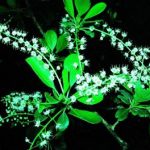TREE LIFE
January 2015
MASHONALAND CALENDAR
Saturday Jan 3rd (NOTE CHANGE OF DAY AND TIME): Botanic Gardens Walk with Tom Muller: Meet at 9.00am in the car park of the Harare Botanic Gardens.
Sunday 18th January – Outing to Southern Cross Farm near Chegutu, courtesy of Jade and Graham Mannix. We will meet at Prince Edward School car park at 8.15 am, for a prompt 8.30 departure. Those who wish may obtain directions to the farm from Mark Hyde. Bring your lunch, drinks and a chair as well as walking shoes, a hat and sunblock.
Saturday 24th January – Visit to Karl van Laeren’s property in Hawkeshead Drive courtesy of Karl and Annelie. We meet at 14.30.
TREE OF THE MONTH
Vitex payos
Family: Lamiaceae (previously Verbenaceae). Common names: Chocolate-berry; Nd: Umtswankela; Sh: Mudyagava.
Etymology: The genus Vitex was named by Linnaeus in his book “Species plantarum”, published in 1753. It comes from the name used by Pliny the Elder for Vitex agnus-castus, derived fom the Latin “vieo” meaning “to weave”, a reference to the fact the Vitex agnus-castus was used in basket weaving. As for the species specific name I do not find any relevant information, maybe one of our readers will enlighten me.
The Lamiaceae family is well known to all as it is a mostly herbaceous group that contains many fragrant species used in perfumery or in cooking: lavenders, mint, spearmint, peppermint, marjoram, basils, sage, rosemary and thyme, to name a few. The Vitex group was initially included in Verbenaceae but DNA studies showed that they were Lamiaceae. Vitex are nevertheless different from other Lamiaceae as they have palmate leaves. Nine Vitex species are represented in Zimbabwe but only Vitex payos has a broad geographic distribution.
Vitex payos is a small to medium-sized tree 4-10 m high, with a rounded crown. It occurs in open woodland and on rocky outcrops and on termite mounds at medium to low altitudes, with a preference for the drier areas.
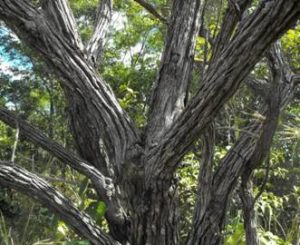
Vitex payos bark
The bark is grey to brown, deeply striated longitudinally, peeling in strips; growing tips and new stems and leaves with tawny woolly hairs. With age the branches become hairless, with prominent leaf-scars.
The leaves are normally 5-foliolate but quite often only 3 or 4 foliolate when the smaller basal pair have not developed. The leaflets are obovate, ranging in size from 3 to 19 cm by 1.5 to 9 cm, the top leaflet being the biggest and the two basal ones being the smallest. They are bright green and hairy on top and very light green and very hairy on the back. The net veining is prominent on both sides and the upper third of the leaflets can be toothed. The petioles are long, 6 to 15 cm, covered with short tawny hair.
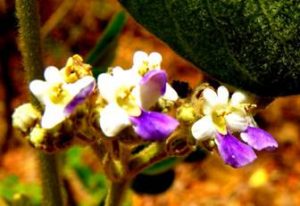
Vitex payos flowers
The flowers grow in axillary heads and are blue, mauve to white, weakly two-lipped. The fruit is fleshy, black when ripe and edible. Recent research has shown that, contrary to earlier assessment, it does contain vitamin C.
Kimondo et al. (2012) state that the fruit pulp contains three water-soluble vitamins: C (ascorbic acid), B3 (niacin) and B6 (pyridoxine). On the other hand, vitamins B1, E, K and β-carotene (provitamin A) were not detected in the fruit pulp. Moreover, from the results, the fruit pulp could provide potassium in large quantities while it is a source of other macronutrients such as magnesium, sodium, phosphorus and calcium in smaller quantities. The pulp contains micronutrients such as iron, manganese and zinc.
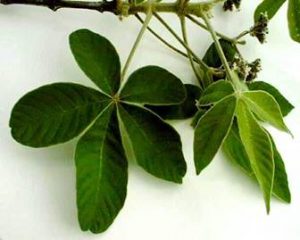
Vitex payos leaves
In the North-Eastern region of Kenya the tree is cultivated for its fruit. The wood of Vitex payos is not durable and very prone to borer, white ants and other attacks. It has occasionally been used to make some item of furniture but its scattered distribution limits its usefulness.
Medicinally the smoke of the burned leaves is inhaled against coughs. A porridge made with the roots is used in the treatment of gonorrhoea and also to prevent abortion.
Sources:
Coates Palgrave, K. 1977. Trees of Southern Africa . Struik, Cape Town.
Gelfand, M. et.al. 1985. The Traditional Medical Practitioner in Zimbabwe. Mambo Press, Harare.
Kimondo, J.M. et al. (2012) Physiochemical and nutritional characterisation of Vitex payos (Lour.) Merr. (Verbenaceae): An indigenous fruit tree of Eastern Africa. Journal of Horticulture and Forestry Vol. 4(10): 161-168.
Van Wyk, B. and Van Wyk, P. 1997. Field Guide to the Trees of Southern Africa . Struik, Cape Town.
Photographs: JP Felu.
– J.P. Felu
OUTING TO LAKE CHIVERO BIRD SANCTUARY 16th NOVEMBER 2014
About 15 of us had the pleasure of visiting the Lake Chivero Bird Sanctuary, a lovely area of miombo woodland with tall trees, sparse grass cover and periodic termite mounds. Sarah kindly acted as recorder and reached about 43 different species including, unfortunately, a jacaranda and a guava in an otherwise reasonably undisturbed area.
We started with Terminalia sericea, a very widespread species, with leaves in clusters at the ends of the branchlets and happily displaying the peeling twigs (tweeling pigs). Interestingly the growing tips had obviously been stung and we could see the early stages of what would develop into the characteristic lollipop galls.
We were delighted to see Ochna pulchra, the Mermaid tree, and although everyone knew what pulchra meant, we all wondered about the origin of the name Ochna. According to Rob Wood in South African, Flowering Trees: a botanical adventure through history, the genus was originally called Jabotapita in 1648 in Brazil, but was later changed by Linneaus to Ochna for various reasons, first of all because one of his rules was that all names must have their root in Greek or Latin and this was a Brazilian word, next because he rejected all European names other than those from Greek or Latin and also harsh sounding names of all non-European or ‘barbarous languages’. He chose an existing Greek plant name, ochne, meaning ‘wild pear’ (and for the Greek scholars this was the name used by Theophrastus of Eresos) and he thought the leaves rather resembled those of the pear. I for one am very happy with that name change! The species was formally named Ochna pulchrum by Hooker from a specimen collected in the Magaliesberg in South Africa by Carl Zeyher in 1841 during a collecting trip with Joseph Burke.
And talking of Burke we saw Burkea africana which bears his name. Burke was a gardener for the Earl of Derby who sent him on an expedition with Zeyher to South Africa to collect animals and plants, at which he was obviously very successful because subsequent to his return to England he married and eventually ended up in America with his wife and ten children. Burkea is a monotypic genus, in other words it is a genus with only one species and was also named by Hooker, who was the first director of the Royal Botanic Gardens at Kew in 1843, although the genus was named by Bentham.
Everybody at Chivero recognised this tree with the tell-tale maroon rusty growing tips and also commented on the bipinnate leaves with alternate leaflets and a single one at the end of each pinna.
We subsequently saw Albizia antunesiana and were able to look at the leaves after Tony had used his extended Captain Hook stick. These are also bipinnate with comparatively large leaflets but in this case the leaflets are in pairs and those at the ends are also a pair. They are distinctively asymmetric and much paler, almost white, on the under-surface. There was no sign of any purple that gives the common name purple-leaved albizia. This colour is usually found on young growth and this was a tall tree viewed against the canopy so even if there had been some purple leaves at the top we would not have seen them.
Miombo woodland occurs on nutrient poor soils and there are often legumes in the understory, one of which we saw was Eriosema englerianum with orangey yellow pea-flowers. The stems die down or are burnt every year and come up again the next year from the woody underground rootstock.
Vangueria randii, Ant-heap wild medlar, which I usually think of as having a higher moisture requirement than one normally expects in miombo woodland, was perhaps for me the most surprising. There were several large termite mounds but the two V. randii we saw weren’t actually on them, although close by. The leaves are hairless (or glabrous, botanically speaking) very unlike the familiar Vangueria infausta, Wild medlar, for which I have always chanted “ Vangueria is hairier” when comparing it with the very similar Vangueriopsis lanciflora, False medlar, which was also there and which is also hairy but has leaves that are very much darker above than below and are more rough than furry to the touch.
As Vicky had predicted, I couldn’t resist the termite mounds, for which I make no apology. They are always so full of interest. There doesn’t seem to have been a fire through there recently and so they were well covered with vegetation, quite prickly and not very inviting. Nevertheless we got close enough to see Capparis tomentosa, a very prickly species with two little hooked spines at the base of the leaves. Those hooked spines are persistent and someone ventured further into the ticket to a green trunk and confirmed it must be the woolly caper-bush because of the pairs of hooked spines. I say spines instead of saying prickles, because prickles are part of the bark and come off easily, like those on a rose. These certainly don’t.
Boscia salicifolia, Willow-leaved shepherds tree, on the termite mound and Faurea saligna, Willow beechwood, in the woodland, both have Salix or willow-like leaves, as the name suggests. The former a very stiff leaf with a cream-coloured midrib, very prominent on the under-surface and the latter hanging gracefully with lateral veins that run to the margin and join up to form a sub-marginal vein – a vein all the way around just inside the margin.
Every picture tells a story and the yellow flowers on the ground told us to look up and stand back and there was Peltophorum africanum, African wattle, in full flower. We had seen a very young one earlier and been able to examine the unique fern-like stipules. The other tree in flower was Vitex payos with little blue flowers. This is known as the Chocolate berry and the conclusion was that it is more chocolate-like to a schoolboy than to an adult.
After lunch some of the party went to look for the avocets which had been seen the previous week. At least we knew if we went back the next week, the odds are in favour of the trees still being there. They certainly wouldn’t have flown away.
– Meg Coates Palgrave
GONAREZHOU TREES
GONAREZHOU is divided into a few vegetation zones. The northern and southern igneous rock complex, a basalt band, is present to the West of Chipinda pools and the top of the cliffs is described as Malvernia sands. The Chilojo cliffs are sandstone and are designated a specific geological feature known as Malvernia slopes and escarpments. This is the area on which we concentrated our attention, together with some of the alluvium species along the Runde River.
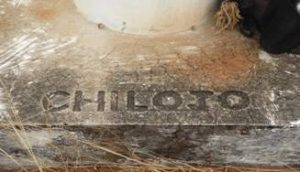
Chilojo cliffs are sandstone
The Chilojo beacon (394.6m. a.s.l.) stands at the far western end of the cliffs of the same name. It is a narrow flat surface of about 250 metres in length joined by a 300 metre-long narrow isthmus of loose rock to the main body of the sandstone massif. Chilojo cliffs have numerous spellings between Chirojo to Chilotjo but it is infinitely more appropriate than the former name, Clarendon Cliffs after a Governor General and Chief Scout of South Africa between 1931-37. This name was still in use in Alan Wright’s book, Valley of the Ironwoods, published in 1972. According to Colin Saunders’ book on this park the name refers to the pink colour of the mucous membranes in the mouth of an elephant which are captured in the pink bands of the cliff face. This majestic feature in the full glow of a setting sun with elephants, dwarfed in comparison drinking from the pools in the Runde, is another one of those Zimbabwean sights enjoyed by anglers and an increasing number of visitors.
We used the services of the local Gonarezhou guide Anthony Kaschula, owner of Gonarezhou Bushcamps, to take us on a four day ramble along the cliffs and to visit some of the trees noted in Lyn Mullin’s book of Historic trees of Zimbabwe. The time was the second week of October. No rain had fallen however we did get a sprinkling of rain during the night which was a great relief from the 44oC temperatures of the day before. Hugely erratic weather patterns are a feature of this area, so coming prepared for extremes is prudent.
The western flanks of this ridge are a busy thoroughfare of criss-crossing megaherbivore meanders as wildlife using the mopane hinterland of the cliffs come down to water on the Runde River. An old road has been fully commandeered by the pachyderms and buffalo, with a deep dung carpet leading one onwards. A white tailed mongoose midden had an assortment of mammalian and vegetative remains but was of a smaller diameter to that of a civetry. A dead buffalo corpse indicated that lions, too, see this area as a strategically productive hunting ground. Clearly, reaching this life-giving water in the pools in the Runde River was never a foregone finale to any trip around the cliff edge.
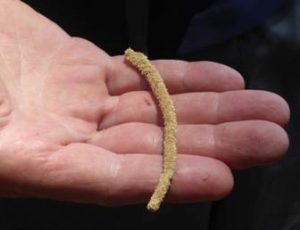
Long male flowers of Milicia excelsa
At the base of the cliffs was Manilkara mochisia, Lowveld milkberry with its leaves clustered like that of Terminalia prunioides which also grows here. Acacia exuvialis, one of the small shrubby glandular group of Acacias, is a special for this area as it is found nowhere else in Zimbabwe. A few small less than a meter tall Rhigozum species were seen on the ecotone between flatlands and the cliff base and R. brevispinosum with simple leaves as opposed to R. zambesiacum or R. obovatum, would indicate a outlier population but this needs further investigation. Higher up the slopes in places inaccessible to elephant, marula trees were in bloom and new leaf but not at all common. The pink sandstone was filled with holes and cavities and in some tubular pieces of rock, the centre would be hollowed out like some petrified water pipe left over from the times that the “Lost City of the Lundi” was in existence! If only we had had a geologist with us.
On the flat top, Albizia forbesii, the Broad pod Albizia, was in flower. These trees were also seen on the top of Kundani Hill, which is a conical hill that can be seen as a feature of the area inland from Lusido pools to the East and comes with some interesting Shangaan folk lore. These trees need pachydermal protection in order to survive pruning, but up here elephants have not left any of their long lasting calling cards, old dung, to indicate that they have ever been here. The steep rocky scarp had served as a rare exclusion zone to these fairly competent latter-day mammothian mountaineers. Only the hand of man was evident in the trig beacon with its neatly stencilled name in the base of the plinth and a cut down tree from the time that the beacon was constructed. Aloe lutescens grew on the ridge too, as did a Newtonia hildebrantii with an Ansellia orchid in its branches. We would also see the aloe species near the Runde River. On our descent were numerous rivers off the cliff-face, which have carved very deep ravines into the alluvial banks. This seemed to be another rich area of botanical biodiversity seen later. Adenium multiflorum, the Sabi Star, was growing amongst rocks on the isthmus but none was in flower. Salvadora australis, with its narrow leaves, grew on the cliff edge too and was a pleasant addition after finding the pepper tasting Salvadora persica, Mustard bush in abundance in the Fishans and Chilojo campsite areas. Acacia senegal with its three thorns made sure we all paid with some spilt blood for invading its domain – my mantra is that good times demand minor sacrifices and blood offerings are both appropriate and far less debilitating than say a bone marrow contribution. The rocky knife-edge isthmus running East from the beacon needed some careful clambering to traverse lest we did indeed make a catastrophic bone marrow sacrifice for our folly! Half way across we encountered a deep green tree that had a felt-like rusty / dirty under surface to its leaves a bit like that of a Euclea natalensis and an elevated midrib on the top surface like one sees in Mimusops. This turned out to be Sideroxylon inerme the White milkwood and like Mimusops and Manilkara, belongs to the Sapotaceae. We missed the milky latex however.
The top of the cliffs is deep sand with small False Mopane, Guibourtia conjugata, predominating beside areas of msasa and mopane along some of the drainage lines. Porcupine enjoyed the rootstock of an unidentified shrub. Landolphia kirkii, the Sand apricot, was in flower and fruit and in spite of its latex-laced fruit, I have been told it makes a good bubble gum substitute if eaten when ripe. I wasn’t tempted to confirm this.
Artabotrys brachypetalus, the Purple hook berry, was also in flower. Two Propeller trees, Gyrocarpus americanus, stood leafless on a large rock fragment closest to the Pinnacle, from were two black eagle nests could be seen if you didn’t suffer vertigo easily. The Pinnacle was covered in thorny Lundi Stars, which do occur as larger but scarce specimens along the Masasanya River too, but I have not seen them anywhere else along the cliffs, suggesting that baboon pressure, fire or porcupines may be this plant’s undoing.
The thought of an unnamed member of a National Parks rhino survey team spending an unplanned night on this pinnacle came to mind. Around 1982/3 in a joint exercise between the Air Force and National Parks, involving a fixed wing and a helicopter, the team were doing a rhino survey when the helicopter pilot decided he would like some photos of the helicopter doing fly pasts of the cliffs and dropped one of his minnows on the Pinnacle with a camera. After numerous reputably hair-raising fly pasts they then put the helicopter down in the river bed for a bit of a sun-downer, leaving the stranded photographer imprisoned on the Pinnacle in full sight of them. The general consensus was that the said photographer needed to be “brought in line” and as a punishment would be left on the Pinnacle overnight in full view of the river razzlers! Wonder who this person was, but it seems like he achieved a record that will never be broken?
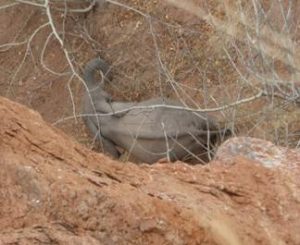
Elephant standing in the shade of the cliff face
By peering over the edge I was able to photograph an elephant we had seen earlier that was standing in the shade of the cliff face, touching the cliff walls with its flank. The way their paths crisscross, the flanks of these cliffs makes it extremely hard for any vegetation to escape being part of these mega herbivores dietary cuisine unless they are particularly unpalatable.
On the way down, a liana-like Adenia fruticosa and a second more stump-like green stemmed specimen were in delicate creamy white flower, with a light green stripe to each petal. Some fruit was also evident. The leaf petiole junction has a pair of swollen glands that typify this genus. Further down a martial eagle called and then departed from its nest in a Baobab on the lower flanks of the cliffs. A single green leaved Maerua angolensis (Bean tree) stood against the contrasting banded sandstone of the cliffs. Its Afrikaans common name in use in Namibia of Lammer Drolletjie Boom, Lamb dung tree after the seeds that look like a string of crookedly arranged sheep faeces, is descriptive and a reminder that botany can be mischievously fun for kids and adults alike. However these less savoury names often get omitted from the printed texts, sadly. Latinizing trees is the final step in botanical exploration but can scare many budding arborophiles away.
We encountered five buffalo bulls semi-asleep on their feet that were unaware of our company. We had seen them from the top of the cliffs so were forewarned of their presence but, in spite of the scant leaf covering offered by the trees, they were elusively hard to find.
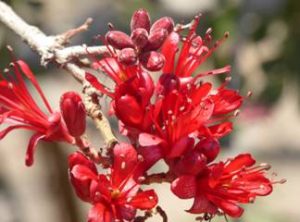
The Schotia capitata in full flower
Our last treat of the seven hour botanical walk was the Schotia capitata in full flower, a first for most of us.
The Milicia excelsa, Mvule or Iroko tree, of Nyahungwe pool area. Is this pool named after the Fish eagles (hungwe) that breed in the crown of the second Milicia, a very large male specimen in the group of five trees? We were fortunate to find them in new leaf, a large deep shiny green leaf. Long male flowers lay draped around on the vegetation below (Cucumber bushes with their trifoliate leaves and a rough sandpaper-like petiole) – these are the second to fourth trees looking at the grove from West to East. They are flanked by two female trees which were in fruit, a swollen green elongated mulberry-like structure.
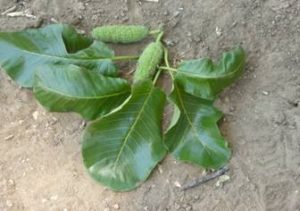
Milicia excelsa, Mvuli tree, fruit
The fruit was avidly being consumed by brown headed parrots and a troop of baboons were picking up any spoils that fell to the ground. At night, bats will move in and these mammals are largely responsible for the trees’ propagation. In parts of its range where gorillas occur this tree forms a late dry season source of sustenance, bringing conflict between commerce and conservation. Why is regeneration not occurring in Gonarezhou however?
The Iroko tree is a member of the Fig family Moraceae and when I tried eating the green fruit, it definitely tasted fig- like. The small woody seeds also resembled the texture of fig in the mouth. The fourth tree to the East (a large male) had a small panel of bark about 9 x 6 inches cut out of it maybe for medicinal purposes when the area was still the domicile of the Shangaan.
We have collected seed and Ant Kaschula will try and propagate them in Harare. They are reported to germinate best if pre-treated in water at 50oC for 15 minutes then planted out in a mixture of chicken manure, sawdust and soil. Do any of these trees still exist in the Haroni Rusitu area? They are certainly a favourite commercial logging timber in Mozambique and are being exported in unsustainable amounts. Also evident amongst the Iroko trees was a Pawnbroker tree Excoecaria bussei and a heavily smashed and stunted Rinorea elliptica, clearly a long suffering favourite of elephant and other browsers.
Also at Nyahungwe pools but more upstream from the Iroko trees is a “forest” of Newtonia hildebrandtii trees. Lyn Mullin records 17 trees – we counted 20, with two youngsters growing on the terrace edge. Porcupine dined on the bark of Cordyla africana and the rather rare Trichilia emetica trees there. The large Diospyros mespiliformis tree mentioned in Historic trees of Zimbabwe was also encountered.
Bartle Bull in “Safari: A chronicle of Adventure” summarises this trip well:
“Today, as before, the best safari is the one closest to nature. With a few very good friends. There is no substitute for walking until you have had enough, and then forgetting exhaustion, you spot the magnificent creatures that no imagination could have conceived. Then stalking or crawling in close, until you smell the elephant or hear the rhino chew the Acacia thorns. Finally, you have learned to require neither a trophy nor a photograph, to respect the animal, to let it continue its life undisturbed, to leave it, quietly, as you found it.”
– Karl Van Laeren
MARK HYDE CHAIRMAN


